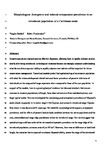Morphological divergence and reduced ectoparasite prevalence in an introduced population of a Caribbean anole
| dc.contributor.author | Bodden, V | |
| dc.contributor.author | Puschendorf, Robert | |
| dc.date.accessioned | 2019-02-21T13:46:45Z | |
| dc.date.issued | 2019-06-30 | |
| dc.identifier.issn | 0952-8369 | |
| dc.identifier.issn | 1469-7998 | |
| dc.identifier.uri | http://hdl.handle.net/10026.1/13333 | |
| dc.description.abstract |
As biological invasions become increasingly common understanding what factors drive a species’ ability to rapidly colonize new habitats will be important for future conservation management. Theoretical models predict that spatial sorting of an invasive population will select for enhanced dispersal-related traits and lower prevalence of parasitic infections. Supporting these, there is a growing body of evidence that demonstrates both features are common in invasive populations, although, these observations stem from mainland systems, over larger spatial scales. Here, we investigated the morphology and ectoparasite prevalence of Maynard's anole (Anolis maynardi) in its native range Little Cayman, and across its introduced range Cayman Brac where it invaded 31 years ago. We tested for morphological divergence, ectoparasite prevalence between the native population and the core, intermediate and range edge populations within the introduced range. In addition, we compared the overall body condition of lizards from each sex between islands using the scaled-mass index. Our results suggest that spatial sorting could have selected for less parasitized individuals on the range edge of the introduced population, across an area of just 39 km2. However, there was no difference in hind-limb length, the character that is expected to enhance dispersal ability, across the range of the introduced population. Instead, the greatest variation in morphology across the introduced range was found in fore-limb length. Finally, both males and females from the introduced population were of significantly higher body condition than the native population, yet ectoparasite intensity had no effect on the body condition of infested hosts. These results highlight the rapid change in forelimb length and overall morphology has occurred rapidly since the species’ first introduction and a clear reduction in parasite prevalence on the range edge of the introduced population. Together these attributes have likely contributed to the successful colonization of Cayman Brac by A. maynardi. | |
| dc.format.extent | 188-196 | |
| dc.language | en | |
| dc.language.iso | en | |
| dc.publisher | Wiley | |
| dc.rights | Attribution-NonCommercial-NoDerivatives 4.0 International | |
| dc.rights | Attribution-NonCommercial-NoDerivatives 4.0 International | |
| dc.rights | Attribution-NonCommercial-NoDerivatives 4.0 International | |
| dc.rights | Attribution-NonCommercial-NoDerivatives 4.0 International | |
| dc.rights.uri | http://creativecommons.org/licenses/by-nc-nd/4.0/ | |
| dc.rights.uri | http://creativecommons.org/licenses/by-nc-nd/4.0/ | |
| dc.rights.uri | http://creativecommons.org/licenses/by-nc-nd/4.0/ | |
| dc.rights.uri | http://creativecommons.org/licenses/by-nc-nd/4.0/ | |
| dc.subject | Anolis maynardi | |
| dc.subject | Trombiculid mite | |
| dc.subject | Little Cayman | |
| dc.subject | scaled-mass index | |
| dc.subject | spatial sorting | |
| dc.subject | invasive species | |
| dc.subject | parasite prevalence | |
| dc.subject | colonization | |
| dc.title | Morphological divergence and reduced ectoparasite prevalence in an introduced population of a Caribbean anole | |
| dc.type | journal-article | |
| dc.type | Journal Article | |
| plymouth.author-url | https://www.webofscience.com/api/gateway?GWVersion=2&SrcApp=PARTNER_APP&SrcAuth=LinksAMR&KeyUT=WOS:000474255600004&DestLinkType=FullRecord&DestApp=ALL_WOS&UsrCustomerID=11bb513d99f797142bcfeffcc58ea008 | |
| plymouth.issue | 3 | |
| plymouth.volume | 308 | |
| plymouth.publication-status | Published | |
| plymouth.journal | Journal of Zoology | |
| dc.identifier.doi | 10.1111/jzo.12664 | |
| plymouth.organisational-group | /Plymouth | |
| plymouth.organisational-group | /Plymouth/Faculty of Science and Engineering | |
| plymouth.organisational-group | /Plymouth/Faculty of Science and Engineering/School of Biological and Marine Sciences | |
| plymouth.organisational-group | /Plymouth/REF 2021 Researchers by UoA | |
| plymouth.organisational-group | /Plymouth/REF 2021 Researchers by UoA/UoA06 Agriculture, Veterinary and Food Science | |
| plymouth.organisational-group | /Plymouth/Users by role | |
| plymouth.organisational-group | /Plymouth/Users by role/Academics | |
| dcterms.dateAccepted | 2019-02-13 | |
| dc.rights.embargodate | 2020-4-7 | |
| dc.identifier.eissn | 1469-7998 | |
| dc.rights.embargoperiod | Not known | |
| rioxxterms.version | Accepted Manuscript | |
| rioxxterms.versionofrecord | 10.1111/jzo.12664 | |
| rioxxterms.licenseref.uri | http://creativecommons.org/licenses/by-nc-nd/4.0/ | |
| rioxxterms.licenseref.startdate | 2019-06-30 | |
| rioxxterms.type | Journal Article/Review |



